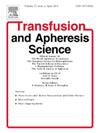计划骨髓采集时实际与理想供体体重的对比
IF 1.2
4区 医学
Q4 HEMATOLOGY
引用次数: 0
摘要
供体选择和收获量计算通常使用实际体重(ABW)。然而,在肥胖供体中,ABW的增加主要反映脂肪组织,而不是富含造血干细胞(HSC)的骨髓。本研究旨在探讨理想体重(IBW)是否比体重(ABW)更能作为估算所需HSC产量的指标。研究设计和方法本研究纳入157名身体质量指数≥ 22的献血者(男性106名,女性51名)。分析收获的造血干细胞与每ABW和IBW收获的体积之间的相关性。另一项分析血红蛋白水平下降与每ABW或IBW收获体积之间的相关性。结果有核细胞总数与每ABW或IBW收获体积、CD34+造血干细胞与每ABW或IBW收获体积、血红蛋白水平下降与每ABW或IBW收获体积之间的相关性均无显著差异。结论IBW和ABW作为估算所需HSC产率的指标无显著差异。此外,结果表明,每ABW的收获量并不过量。本文章由计算机程序翻译,如有差异,请以英文原文为准。
Actual versus ideal donor body weight in planning bone marrow harvest
Background
Donor selection and harvest volume calculation typically use actual body weight (ABW). However, in obese donors, increased ABW mainly reflects adipose tissue rather than hematopoietic stem cell (HSC)-rich bone marrow. This study aimed to investigate whether ideal body weight (IBW) is a better indicator than ABW for estimating the required HSC yield.
Study design and methods
This study included 157 donors (106 men and 51 women) with a body mass index of ≥ 22. An analysis of the correlation between harvested HSCs and harvested volume per ABW and IBW was performed. Another analysis of the correlation between the decrease in hemoglobin levels and the harvested volume per ABW or IBW was performed.
Results
No significant differences were observed in the correlations between total nucleated cell counts and the harvested volume per ABW or IBW, between CD34+ HSCs and the harvested volume per ABW or IBW, and between the decrease in hemoglobin levels and the harvested volume per ABW or IBW in all donors and obese donors.
Conclusions
These results showed no significant differences between IBW and ABW as indicators for estimating the required HSC yield. Additionally, the results showed that harvesting per ABW was not excessive.
求助全文
通过发布文献求助,成功后即可免费获取论文全文。
去求助
来源期刊
CiteScore
3.60
自引率
5.30%
发文量
181
审稿时长
42 days
期刊介绍:
Transfusion and Apheresis Science brings comprehensive and up-to-date information to physicians and health care professionals involved in the rapidly changing fields of transfusion medicine, hemostasis and apheresis. The journal presents original articles relating to scientific and clinical studies in the areas of immunohematology, transfusion practice, bleeding and thrombotic disorders and both therapeutic and donor apheresis including hematopoietic stem cells. Topics covered include the collection and processing of blood, compatibility testing and guidelines for the use of blood products, as well as screening for and transmission of blood-borne diseases. All areas of apheresis - therapeutic and collection - are also addressed. We would like to specifically encourage allied health professionals in this area to submit manuscripts that relate to improved patient and donor care, technical aspects and educational issues.
Transfusion and Apheresis Science features a "Theme" section which includes, in each issue, a group of papers designed to review a specific topic of current importance in transfusion and hemostasis for the discussion of topical issues specific to apheresis and focuses on the operators'' viewpoint. Another section is "What''s Happening" which provides informal reporting of activities in the field. In addition, brief case reports and Letters to the Editor, as well as reviews of meetings and events of general interest, and a listing of recent patents make the journal a complete source of information for practitioners of transfusion, hemostasis and apheresis science. Immediate dissemination of important information is ensured by the commitment of Transfusion and Apheresis Science to rapid publication of both symposia and submitted papers.

 求助内容:
求助内容: 应助结果提醒方式:
应助结果提醒方式:


